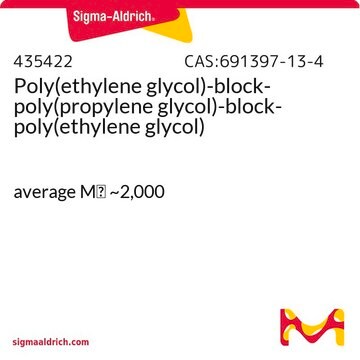If this product has an expiration or retest date, it will be shown on the Certificate of Analysis (COA, CofA). If there is no retest or expiration date listed on the product's COA, we do not have suitable stability data to determine a shelf life. For these products, the only date on the COA will be the release date; a retest, expiration, or use-by-date will not be displayed.
For all products, we recommend handling per defined conditions as printed in our product literature and website product descriptions. We recommend that products should be routinely inspected by customers to ensure they perform as expected.
For products without retest or expiration dates, our standard warranty of 1 year from the date of shipment is applicable.
For more information, please refer to the Product Dating Information document: https://www.sigmaaldrich.com/deepweb/assets/sigmaaldrich/marketing/global/documents/449/386/product-dating-information-mk.pdf
435503
Poly(propylene glycol)-block-poly(ethylene glycol)-block-poly(propylene glycol)
average Mn ~3,300
Sinónimos:
Pluronic® 31R1
Seleccione un Tamaño
$72.10
Precio de catálogo$75.90Ahorre 5 %Disponible para envío el14 de abril de 2025Detalles
Seleccione un Tamaño
About This Item
$72.10
Precio de catálogo$75.90Ahorre 5 %Disponible para envío el14 de abril de 2025Detalles
Productos recomendados
Formulario
viscous liquid
mol peso
average Mn ~3,300
composición
PEG, 10 wt. %
índice de refracción
n20/D 1.454
tensión superficial
34 dyn/cm, 25 °C, 0.1 wt. % in H2O
viscosidad
660 cP(25 °C, Brookfield)(lit.)
temperatura de transición
softening point −25 °C
cloud point 25 °C (1 wt. % aqueous solution)
densidad
1.018 g/mL at 25 °C
HLB
2.0 - 7.0
cadena SMILES
O2C(C2)C.O1CC1
InChI
1S/C3H6O.C2H4O/c1-3-2-4-3;1-2-3-1/h3H,2H2,1H3;1-2H2
Clave InChI
RVGRUAULSDPKGF-UHFFFAOYSA-N
Categorías relacionadas
Descripción general
Aplicación
Características y beneficios
Información legal
Código de clase de almacenamiento
10 - Combustible liquids
Clase de riesgo para el agua (WGK)
WGK 3
Punto de inflamabilidad (°F)
Not applicable
Punto de inflamabilidad (°C)
Not applicable
Elija entre una de las versiones más recientes:
¿Ya tiene este producto?
Encuentre la documentación para los productos que ha comprado recientemente en la Biblioteca de documentos.
Los clientes también vieron
Artículos
Mesoporous materials self-assemble from sol-gel precursors and amphiphiles, forming versatile structures for various applications.
-
How can I determine the shelf life / expiration / retest date of this product?
1 answer-
Helpful?
-
-
How is shipping temperature determined? And how is it related to the product storage temperature?
1 answer-
Products may be shipped at a different temperature than the recommended long-term storage temperature. If the product quality is sensitive to short-term exposure to conditions other than the recommended long-term storage, it will be shipped on wet or dry-ice. If the product quality is NOT affected by short-term exposure to conditions other than the recommended long-term storage, it will be shipped at ambient temperature. As shipping routes are configured for minimum transit times, shipping at ambient temperature helps control shipping costs for our customers. For more information, please refer to the Storage and Transport Conditions document: https://www.sigmaaldrich.com/deepweb/assets/sigmaaldrich/marketing/global/documents/316/622/storage-transport-conditions-mk.pdf
Helpful?
-
Active Filters
Nuestro equipo de científicos tiene experiencia en todas las áreas de investigación: Ciencias de la vida, Ciencia de los materiales, Síntesis química, Cromatografía, Analítica y muchas otras.
Póngase en contacto con el Servicio técnico







